Smooth Spelling Starts the Day -- Daily Five-Minute Lessons
Each morning I got to present a mini lesson to the entire elementary school and parents at the morning assembly. Below is a series of pictures from the final session where we made sense of the spelling of <rough>.
The homophone principle and the spelling of <rough>
By this session we had learned the homophone principle that “when words sound the same but are not related in meaning -- where possible -- they will use different spellings to mark that difference in meaning.” With that background, I shared the definition of the homophone <ruff>.
ruff 1 |rəf| |rəf| |rʌf|
noun
1 a projecting starched frill worn around the neck, characteristic of Elizabethan and Jacobean costume.
Since the spelling <ruff> is used up for the word with the same origin as <ruffle> is used up, another spelling is needed for the word with the meaning of “not smooth.”
The trigraph <ugh> can be used for /f/, (as in <laugh>, <enough>, and <cough>) so we could start spelling the word for ‘not smooth’ like this <*ruugh>. But this group now knows that no complete English spelling can use <uu> because we already have a “double - u”!
So what can we do???
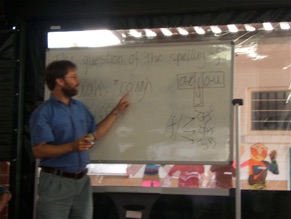
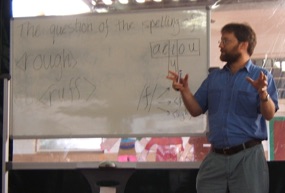
To understand the spelling of <rough> we needed to learn that when there is a reason that you can’t use a <u>, we use the <o> instead. So the unallowable spelling <*ruugh> needs to be re-written <rough>.
The big ideas targeted by all of these examples are that English spelling a) makes sense, and b) that its main function is to represent meaning.
We only know to investigate the spellings of words like <rough> and <does> if we start with the assumption that there is a logic for these spellings to investigate. Studying the spelling of words like <rough> (and <does> that was studied earlier in the week) can be used to refine understanding of this idea that spelling is mainly about representing meaning.
What we learn from <rough> and <ruff>:
Homophone principle: The fact that words that sound the same but are unrelated in meaning use different spellings to mark that meaning difference where possible signals that the representation of meaning is of more fundamental importance than is the representation of sound.
What we learn from <does> and <do>:
The morphophonemic principle: This is the principle in oral English that morphemes (bases and affixes) can have multiple pronunciations (phonological representations). English spelling, however, has evolved to mark those morphemes (meaning bearing elements) with consistent spelling -- even when the pronunciation of that morpheme changes.
Thus although the base <do> is pronounced differently in the base word <do> than it is in the complex word <does> (with the structure <do + es>), the spelling of the base is consistent.
Studying these two words typically presented as “irregular” shows the learner that primary job of spelling is to represent meaning and that it makes sense!
Thanks to the staff and students of AISJ for inviting me to explore words with them!
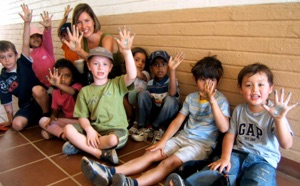
This Kindergarten class had a great time going on treasure hunts for vowel letters, and was able to confirm if they found them by checking their hands to see if the letter in the word was on one of their fingers written in the old “a,e,i,o,u and sometimes y” way.
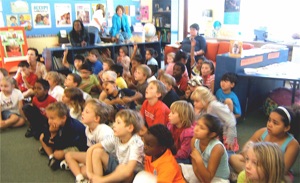
The parallels of grade 2 classes in at AISJ learning how to build a word web on the base <help> from a matrix during a lesson drawn from Teaching How The Written Word Works. (See lessons from that book below.)
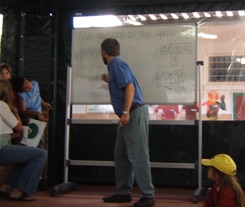
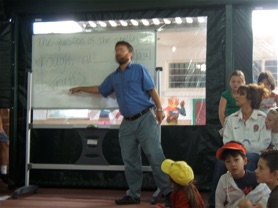



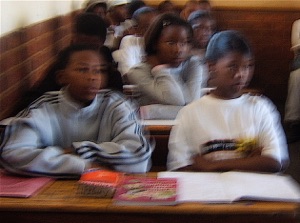

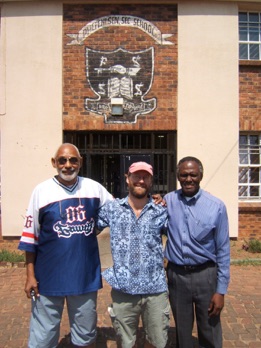


When asked to suggest a word which they’d like to investigate, the young man above suggested <etymology>.
After lessons, 90 kids line up for lunch provided by José.
The same process for investigating a spelling as anywhere else: A matrix, word sums and starting off with the questions: What does it mean? What is the structure? Are there related words that help? What graphemes (1, 2 or 3 letter combinations can we use?

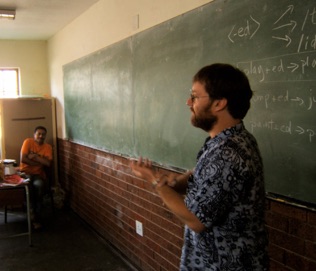
Teboho Trust founder, José Bright watches on with a big smile as Pete models counting syllables with fingers on his wrist to work out the pronunciations of the <-ed> suffixes in the words <played>, <jumped> and <painted>. The past tense suffix only adds a syllable when added to one of those words, and it is never pronounced /ɛd/. However, when the letters <ed> are not used as a suffix, they can (e.g., bed).
Hugh (on left), Pete and a volunteer teacher pose in front of the school for what Hugh -- with his great laugh and smile -- calls the “Oreo shot”!
“In Soweto, we need the children that raise the village.”
José Bright, Founder, Teboho Trust
My visit to Teboho Trust:
When I arrived, José was in mid grammar lesson on parts of speech with about 40 students I estimated ranging from Grade 1 to 6 (more at the upper end) who were clearly attentive, and who held great respect for Mr. Bright. As a testament to these students, and José’s work, responses of the children easily matched (and often surpassed) what many children in similar grades in Kingston schools could achieve in such a grammar lesson.
As José’s lesson ended, I was introduced, and jumped into a lesson exactly like I had conducted in the Grade 4/5 classes I taught at AISJ. After a few minutes, José asked if I’d mind if the rest of the older students (up to end of high school) joined us. With that the room reached capacity! The students were just wonderful. José and the other teachers were so excited by the response of the kids to our investigations with words. As José said – their interest was clearly seen in their eyes. Consider the level of orthographic investigation this group challenged me to provide…
I began as I often do, by describing my own history as a teacher with terrible spelling skills who struggled with the spellings of words as basic as <really>. I explained how after ten years as a teacher who had to confirm this spelling by looking in a dictionary, someone simply showed me that the structure (real+ly) explains the need for two <l>’s. With the answer rooted in understanding rather than memorization, I never needed to look this word up again.
With that introduction to word structure, I began to build a matrix on the word <real>. First with my own suggestions, then with theirs, we added affixes to the matrix to produce words such as <realize>, <unreal>, <surreal>, <reality> and more. We then ran into the homophone <reel> and were thus able to get into the homophone principle that where possible, words of different meaning that sound the same use different spellings to mark that difference. As a second example, I was able to jump over to another favourite hook of mine -- the homophones <please> and <pleas>. These spellings are effective at revealing the pattern that one job of the silent <e> is to prevent a word from looking like a plural if it is not (please is not more than one plea!). One investigation that seemed to be particularly helpful was working out how to go from the base <please> to its past tense <pleased>. Very logically, a student suggested adding a suffix <*-d> in the word sum I started. To establish the spelling of the suffix <-ed> I stepped back to ask what a word sum would look like if I wanted to go from the base <play> to saying “yesterday I __________.”
Right away, students suggested the suffix <-ed>. So we completed the sum, and I asked them how they pronounced the <-ed> suffix in this word. Using the angle and slash brackets to distinguish letters from pronunciation I wrote the result they produced, /d/, and with the help of counting out syllables (one for both present and past forms), pointed out that that the <e> of the <-ed> suffix didn’t seem to be pronounced at all. We continued by making a word sum for the past of <jump> then for <paint>, each time using the slash brackets to mark the phonemes they accurately pronounced (/t/ and /id/ respectively). Just like students at AISJ, they were quite taken with the fact that <jumped> so clearly used <-ed> to represent /t/. It is always striking to me how powerful it is to simply teach the three pronunciations of <-ed>, the most basic of suffixes. With this five minute lesson, the morphophonemic nature of English, and how the spelling system works to represent units of meaning consistently, can be introduced in such a straightforward manner that is easily captured by young students’ understanding – whether in a Kingston public school, a wealthy international school, or a Saturday morning working with kids from the Soweto townships.
With the spelling of the <-ed> suffix established, I was able to return to consider the spelling of <pleased>. The student who had offered the hypothesis of the <-d> suffix, now saw it should be <-ed>, but was obviously troubled by the fact that it appeared like he was suggesting a spelling that he knew was incorrect, <*pleaseed>. I noted that I was pretty sure I understood what was troubling him -- that he knew there couldn’t be two <e>’s in <pleased>. He and the class showed they were right with me through all of this with immediate expressions of acknowledgement and desire to understand when I confirmed this source of their confusion.
I could now establish one more key orthographic fact by writing the word sum: please/+ing --> pleasing on the board. I told the class that because I was explicitly taught, I happened to know that when you add a suffix that begins with a vowel letter (like <-ing>) to a word or stem ending in a single silent <e>, that vowel suffix replaces that final letter, as shown in the word sum for <pleasing>. Now we could return to resolve our word sum please + ed --> _______________. It was easy to establish that like <-ing>, <-ed> started with a vowel letter, so just like <-ing>, this suffix also had to replace the single, silent <e> of <please>. And so the students’ concern that adding an <-ed> suffix would produce the wrong spelling was resolved.
With a mind to make sure I was addressing the youngest students in the crowd as much as possible, but also re-emphasize patterns everyone needed to internalize, I had also worked through the spellings of <cats> and <dogs>. Note that this word structure instruction was being used to provide differential instruction for a K-12 classroom! The packed house was full of smiles and laughter as young and old put their hands on their throats to distinguish how the /s/ and /z/ is produced. Give it a go. It’s all in the throat!
Next my favourite matrix on <do> and <go> for does, doing, done; going, not only reveals the common /z/ pronunciation of <s> again, but it also shows the regularity of the “irregular sight words” <does>, <done> and <gone>. Absent structural understanding, these three simple inflections are typically relegated to instruction by memorization and used as evidence of how disordered and frustrating English spelling is! What a terribly unnecessary and damaging message to send children – especially for those who are struggling to make sense of reading and writing!
Consider just some of the seeds of understanding that were being planted in this short visit. Students were learning key reliable patterns of English spelling including the facts that a) vowel suffixes replace single silent <e>’s while consonant suffixes do not, b) that the spellings of prefixes, suffixes and bases remain the same to show connections in meaning, despite pronunciation shifts, c) words that sound the same but have different meanings (homo+phones – same + sounds) use different spellings to mark different meanings, and d) the spelling of words is so ordered that it can be understood with the help of tools like a word matrix and word sums, instead of just memorized. More simply put, these students were beginning to learn that English spelling is about meaning, and can be fun to problem-solve. These messages that absent most children’s schooling -- whatever the economic circumstance, were received with interest and enthusiasm by this group of economically, but clearly not intellectually impoverished students.
Lest you think I was shooting way over these kids’ heads, consider the first response to my offer to discuss the spelling of words that caused students’ difficulty or confusion. An eager student, that I guessed to be in Grade 5 or 6, (see picture on website) shot up his hand and offered the word <etymology>! Students were obviously keen to show off what they’d been learning with José. Who was I not to investigate? I was able to discuss the common stem –ology for ‘the study of’ and the underlying meaning of the base <loge> for speech, account, reason, and it’s structural and meaningful relation to the word <logic> (note the structure loge/+ic). However, I was quite happy to point out that I had not yet considered the underlying meaning of <etym>. Kids armed with donated dictionaries started to look up the word, and I had my “Word Stems” by Kennedy handy. Together we discovered that the underlying meaning of this base grew from the Latin Root for ‘true’ and that <etymology> had to do with the “true origin of words” a citation I later confirmed with my Oxford.
I could not have invented a more satisfying way to conclude my work with spelling over these three plus weeks. After my lesson, I had the chance to help with the preparation of lunch for the 90 students, including running out to a Soweto grocery store to pick up some needed cheese, and then join them as they prayed before lunch by singing like Ladysmith Black Mumbazo. My-oh-my. I only regret I was too shy to ask if I could video tape them singing!
I encourage you to go visit www.teboho.com. José’s reworking of the saying into “It takes a village to raise a child” describes perfectly what they are all about and what I saw going on. Instead of taking kids out of the village, they were building the leaders of the community with sound education, respect, food and love. When a village is broken, children who are equipped to raise the village are needed. I can assure you that whatever support or spreading of the word of Teboho Trust you can offer will be put to good use.
Please visit their website for more details on what they do and/or if you are interested ask me for a copy of the DVD highlighting the children’s work and personal stories. Many projects that sound like this have their hearts in the right place, but can often create other unintended problems. From what I could see in my brief visit, José and his team seems to be doing everything right.
Real Spelling meets local South African students in Soweto...
On my first day off in Johannesburg, I was fortunate enough to be taken by Hugh, a retired businessman/supply teacher at AISJ, to the site of an organization called the Teboho Trust. Since arriving in South Africa recently, Hugh has made this organization, founded by José Bright, into his main passion. It’s easy to see why. José is an American who has been in South Africa for over 12 years. A number of years ago, local elders thankful for his work performed a ceremony to officially adopt José as an elder in the community. It was in that ceremony that he was given the name “Teboho” meaning “thank you”. Teboho Trust, funded and run by José, scattered donations and a handful of volunteers is a truly remarkable project. It is not only giving particularly vulnerable children living in Soweto townships opportunities to develop themselves, but it is helping the children develop the community in which they live. As José describes, given the current challenges in Soweto, they have adapted the old saying to the following assumption “It takes a child to raise the village”.
José was in Johannesburg as an educational consultant when he discovered the financial cost to educate a child. Public education in South Africa is not free. He started by committing to support 5 students to the end of high school and college, but after interviewing the 10 selected by the school he approached, he committed to supporting all 10. He soon discovered these kids needed more than finances, and one way he addressed this need was starting what has become the flagship program of Teboho Trust, the “Saturday Academy”. Particularly vulnerable children who live in the Soweto townships can choose to come for an extra day of school organized and run by José and a handful of volunteers that is currently housed in a local high school building across the street from Nelson Mandela’s old house (Desmond Tutu’s house is on the same street!). Along with José, other volunteer teachers, including some from the local community and some from AISJ, prepare lessons in academics, life and business skills, as well as a free lunch. Consider just two impressive statistics they have achieved. In five years they have a 0% teen pregnancy rate, and they boast a number of graduates already succeeding in, and set to go to college.
Copyright Susan and Peter Bowers 2008



Looking for information on my visit to Teboho Trust?
Scroll down to the middle of this page for stories and images of my visit to the amazing Teboho Trust in Soweto.
Hello from the American International School of Johannesburg (AISJ) in South Africa!
My visit with the American International School of Johannesburg was a real treat. The staff and students are amazing. The pre-K to Grade 3 teachers have been put through the paces. It’s such a delight to find yet another group of teachers who work together as a team, and are happy to work hard to take on challenging content. While this school has one of the original Real Spelling Tool Boxes, there has been so much turn over in teachers in kids that most of the teachers are entirely new to the process. A number who have been working with it for a time have found impressive ways to make this instruction fit their teaching situations. While it wasn’t my first intent, the Pre-K teachers have taken to investigating the handwriting from the Manual. In the brain-storm session on strategies to share teacher and student learning, there was much excitement about ways students could present their learning.
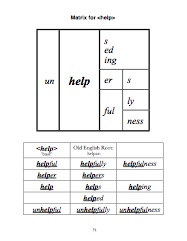
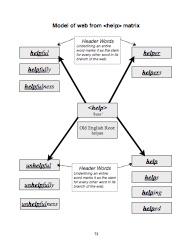






y
This vowel letter chart signals the “job share” arrangement between <i/y>, <o/u> and <a/e>. When for some orthographic convention, one of these letters cannot be used, it’s partner takes on that role.




